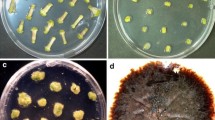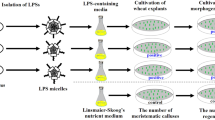Abstract
The effect of preliminary treatment with inducers of resistance (salicylic and hexanoic acids) at the level of callose synthesis in cells of three onion cultivars have been studied. The ability of these inducers to increase the resistance of onion to pathogenic infections at low concentrations was shown. Using the method of spectrofluorimetry, we demonstrated that the treatment of onion scales with salicylic and hexanoic acids led to the priming of the reaction of callose accumulation.
Similar content being viewed by others
References
Dmitriev, A.P., Fitoaleksiny i ikh rol’ v ustoichivosti rastenii (Phytoalexins and Their Role in Plant Resistance), Kyiv: Naukova Dumka, 2000.
Tarchevskii, I.A., Signal’nye sistemy kletok rastenii (Signaling Systems of Plant Cells), Moscow: Nauka, 2002.
Yigal, R., Cohen E., β-Aminobutiric Acid-Induced Resistance Against Plant Pathogens, Plant Disease, vol. 86, no. 5, pp. 448–452.
Kauss, H., Callose Synthesis, in Membranes: Specialized Functions in Plants, Guildford, UK: Bios Sci. Publ., 1996, pp. 77–92.
Polyakovs’kii, S.O., Emel’yanov V.I, Dmitriev O.P. Quantitative Determination of Callose Accumulation in Three Allium cepa Cultivars Treated with Resistance Inducers, in Fiziologiya rastenii: problemy i perspektivy razvitiya: Tez. dokl. Mezhdunar. konf. (Abstr. Int. Conf. “Plant Physiology: Problems and Prospects”), Kyiv, 2009, vol. 2, pp. 361–364.
Scopes, R., Metody ochistki belkov (Methods of Protein Purification), Moscow: Mir, 1985.
Aist, J., Papillae and Related Wound Plugs of Plant Cells, Annu. Rev. Phytopathol., 1976, vol. 14, pp. 145–165.
Conrath, U., Beckers, G., Flors, V., Garcia-Agustin, P., Jakab, G., Mauch, F., Newman, M., and Pieterse, C., Poinssot B., Pozo M., Pugin A., Schaffrath U., Ton J., Wendehenne D., Zimmerli, L., and Mauch-Mani, B., Priming: Getting Ready for Battle, Mol. Plant-Microbe Interact., 2006, vol. 19, pp. 1062–1071.
Ton, J., Jakab, G., Toquin, V., Iavicoli, A., Flors, V., Maeder, M., Metraux, J.-P., and Mauch-Mani, B., Dissecting the β-Aminobutyric Acid-Induced Priming Pathways in Arabidopsis, Plant Cell, 2005, vol. 17, pp. 987–999.
Ton, J. and Mauch-Mani, B., β-Aminobutyric Acid-Induced Resistance against Necrotrophic Pathogens Is Based on BABA-Dependent Priming for Callose, Plant J., 2004, vol. 38, pp. 119–130.
Van Hulten, M., Pelser, M., Van Loon, L., Pieterse, C., and Ton, J., Costs and Benefits of Priming for Defense in Arabidopsis, Proc. Nat. Acad. Sci. USA, 2006, vol. 103, pp. 5602–5607.
Koch, E. and Slusarenko, A., Arabidopsis Is Susceptible to Infection by Downy Mildew Fungus, Plant Cell, 1990, vol. 2, pp. 437–445.
Hamiduzzaman, M., Jakab, G., Barnavon, L., Neuhaus, J.-M., and Mauch-Mani, B., β-Aminobutiric Acid-Induced Resistance Against Downy Mildew in Grapevines Acts through Potentiation of Callose Formation and Jasmonic Acid Signalling, Mol. Plant-Microbe Interact., 2005, vol. 18, pp. 819–829.
Zimmerli, L., Jakab, G., Metraux, J.-P., and Mauch-Mani, B., Potentiation of Pathogen-Specific Defense Mechanisms in Arabidopsis by β-Aminobutyric Acid, Proc. Nat. Acad. Sci. USA, 2000, vol. 97, pp. 12920–12925.
An, Q., Huckelhoven, R., Kogel, K., and van Bel, A., Multivesicular Bodies Participate in a Cell Wall-Associated Defense Response in Barley Leaves Attacked by the Pathogenic Powdery Mildew Fungus, Cell. Microbiol., 2006, vol. 8, pp. 1009–1019.
Ryals, J., Neuenschwander, U., Willits, M., Molina, A., Steiner, H., and Hunt, M., Systemic Acquired Resistance, Plant Cell, 1996, vol. 8, pp. 1809–1819.
Emel’yanov, V.I., Kravchuk, Zh.N., Polyakovs’kii, S.O., and Dmitriev, A.P., Deposition of Callose in Treatment of Cells of the Tomato Plant (Lycopersicon esculentum L.) with Biotic Elicitors, Tsitol. Genet., 2008, vol. 42, no. 2, pp. 21–28 [Cytol. Genet. (Engl. Transl.), 2008, vol. 42, no. 2, pp. 90–95].
Author information
Authors and Affiliations
Corresponding author
Additional information
Original Ukrainian Text © S.O. Poliakovskiy, O.P. Dmitriev, 2011, published in Tsitologiya i Genetika, 2011, Vol. 45, No. 4, pp. 50–54.
About this article
Cite this article
Poliakovskiy, S.O., Dmitriev, O.P. Study of priming for callose accumulation in Allium cepa during treatment with biotic inducers. Cytol. Genet. 45, 245–248 (2011). https://doi.org/10.3103/S0095452711040086
Received:
Published:
Issue Date:
DOI: https://doi.org/10.3103/S0095452711040086




